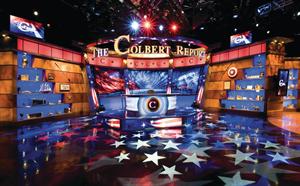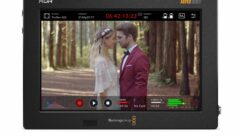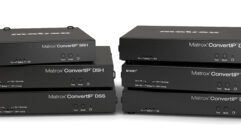

Video Backdrops: Fade to Back
From the set of The Colbert Report to rental and staging, video systems that are designed to be seen but not necessarily watched have become big business and a real advantage for users.
If you’re a fan of the colbert report on Comedy Central, you probably watch it to see Stephen Colbert skewer politicians, parody the day’s news, and satirize conservative talk show pundits. Chances are you haven’t noticed that earlier this year, the show’s elaborate set became the first installation of Christie MicroTiles technology.
MicroTiles combine DLP and LED technology into modular, 16-by-12-inch displays that can be stacked and aligned to create videowalls of various shapes and sizes. The new Colbert stage comprises 41 MicroTiles. There are 13 arranged into three horizontal displays beneath Colbert’s desk (1×4, 1×5, and 1×4), and 28 more configured as four angled 1×7 vertical columns along the set’s backdrop. During the show, the tiles display high-definition video and graphics created for the show.
Jim Fenhagen, chief designer of the Colbert set and senior vice president of design at Jack Morton PDG, which specializes in broadcast studios, says he was looking for a way to implement strips of video that fit seamlessly into the existing space. But just as importantly, “The set had to be amplified visually without being too distracting,” he says.
Without being distracting. In other words, unlike traditional uses of video, the technology integrated into the Colbert set (and many others like it) was meant to be seen, but not always watched. It’s part of a growing application of video systems for creating engaging backdrops that are part videowall, part signage, and totally unique in their requirements.
Such video backdrops are starting to pop up in more and more places, from cable and network news sets to rental and staging applications. “They’re virtual scenery,” Fenhagen tells Pro AV. “These giant walls can be anything you want them to be and the screens become part of the architecture.”
And in a welcome twist on modern video display trends, video backdrops are drawing increased interest not necessarily because the underlying technology is getting cheaper, but because it’s getting better.
Jim Durant is the broadcast market manager for Barco North America. Several years ago, the company took display technology that it normally sold to control rooms and spun it out as a line of backdrop solutions for the broadcast industry. “And we didn’t just want to limit the technology to studios, but we also wanted it for digital signage and other applications,” he says. The systems created the desired “wow” factor among clients and saw rapid adoption, especially in the competitive broadcast market.
“We thought all this would peak around 2007,” Durant explains. “But it continued to increase and has reached a steady plateau.”
Matching Technology to the Backdrop
There are three primary ways to create a video backdrop. In order of cost, they include traditional flat-panel displays at the low end, then rear- or front-projection systems, and finally modular cube/tile displays. LED walls are a fourth option, but on TV sets in particular, they can suffer a basic shortfall: LED walls don’t always look good on camera.
“LED on-camera typically moirés,” says Dale Cihi, president of Videofilm Systems, which did the AV installation on the Colbert set. “It can be a nightmare after we do large jobs. They turn on the LED and have a fit because they have a brand-new HD set and no one thought to test focal lengths and how the LEDs would inteact with the cameras.” (Cihi says he’s working with Stewart Filmscreen engineers on a possible solution that would position a layer of vinyl in front of the LED to negate the moiré effect.)
In fact, when choosing a video backdrop technology, AV designers and integrators say it’s important to understand what types of content the client plans to display. If it will be part of a TV set, the team needs to determine what camera angles they’ll use, how close they might zoom in, and more. For example, if the client needs to display very fine detail, such as a map, they will need a solution that gives them very high resolution. Fenhagen says that when his clients are going for a certain look, they’ll bring in samples of the available technologies and put them on camera.
Ultimately, no one size fits all, and matching a system to a client’s application means assessing short- and long-term requirements. “People jumped on flat-panel displays first, then cube walls, then large-screen projection to achieve the effect of a live event in a studio,” Durant says. “Now many are back to cubes and similar technologies.”
Durant and others say projection highlights another important consideration when selecting backdrop technology: space. Although the cost of projection systems has dropped dramatically, “Traditional projection eats up space,” Durant says. “In a studio setting especially, that space is a premium.” Cube or tile technology, for instance, can reduce the space needed by a factor of 10.
Clients with limited budgets typically look toward flat panels first, especially as the price of large-format displays has dropped. If they’re only interested in branding, projection fits the bill. But as the video backdrop becomes more dynamic and central to the installation, they need to consider the ongoing cost of maintenance. For example, the more a backdrop will be in use, the more often the client may need to change projector lamps. And if it’s a blended projection backdrop or a flat-panel display wall, they’ll need to factor in color balancing and other ongoing issues.
Often, experts say, clients can be convinced to invest up-front in costlier technology, such as LED-lit displays, if they understand the longevity of the solutions. An inherent strength of video backdrops, and a reason so many organizations adopt them, is that they’re more flexible and adaptable than traditional sets. In broadcasting, that means a studio can be used over and over for different shows without dramtically changing the set.
Integrators like Cihi believe more clients may start to lease video backdrop equipment. In fact, those in the market say rental and staging is a growing part of the video backdrop business. And if clients can re-use technology even more, it increases the return on their investment. Durant says NBC used Barco technology for a studio backdrop at the 2008 Summer Olympics in China. It then took the set and repurposed the video systems for a control room back in the U.S.
The Christie MicroTiles that now adorn the set of The Colbert Report were designed to address nearly all the requirements of a video backdrop solution. “Its innovative media easily adapts for entertainment spaces,” Fenhagan says. The tiles color-correct themselves, integrate easily with the set, and consume less energy than other solutions. Chances are when Colbert undergoes another set change, the video backdrop will be pressed into service again.










